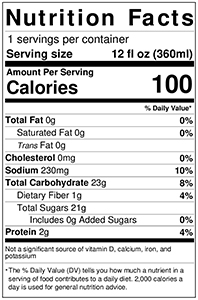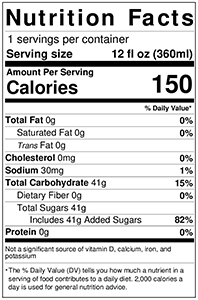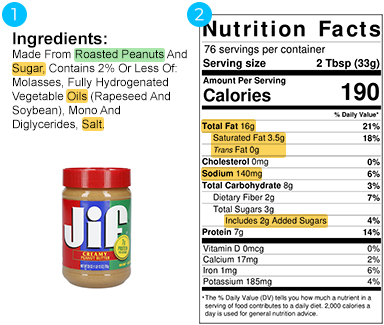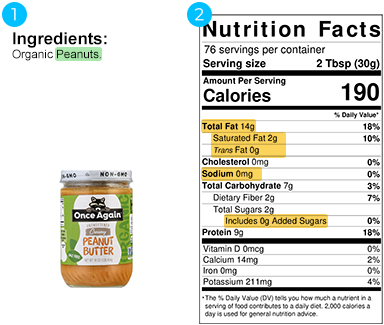What I’m about to say may seem hard to believe but it’s true. A study was recently published in the Journal of Nutrition Education and Behavior where they quizzed participants on the meaning of the food labels “BEST If Used By” and “USE By.” Despite the participants feeling confident that they understand the food label meanings, only 46% of participants knew the correct meaning of “BEST If Used By” and just 24% knew the correct meaning of “USE By.” And if that wasn’t enough, the study then educated the participants on the food label meaning and quizzed them again… Only to find that nearly half of participants still didn’t understand the correct meanings. And this got me thinking, if those two labels can be so easily misunderstood then understanding a full nutrition label must seem like rocket science.
I mean let’s look at these two food labels for example. Which one is the healthier option? The first one has less calories and sugar, but it also has 10% of your daily value in sodium. And neither have a significant source of vitamins, minerals, fiber, or protein. Well, the first label is 100% carrot juice while the second label is Pepsi. Now the added sugar section may have given it away but there’s much more to the story here than what’s shown on the label. So today, I’m going to detail what on a nutrition label warrants our attention and what can be ignored. Then I’m going to quiz you at the end with a few label examples to see if you can read a nutrition label like a dietician. So, let’s get into it!
The Best Foods Don’t Have Labels
Let’s start off by establishing that the best foods are whole foods. Whole foods are unprocessed foods that we could grow in a garden like apples, carrots, lettuce, peas, and sunflower seeds. And each of these foods has a unique combination of vitamins, minerals, antioxidants, and phytochemicals that make them extremely healthy. Because of this, these whole foods don’t require a nutritional label in stores. It’s why you can get your bananas without any packaging or ingredient labels. But as soon as a food undergoes processing, like carrots being turned into carrot juice, then it warrants a nutrition label. And as food undergoes processing, it tends to diminish the nutrient content in the food. Therefore, it’s healthiest to buy food that has undergone the least amount of processing. Now it’s difficult to live off whole foods entirely. For example, sometimes it’s easier to buy cooked and canned beans or peanut butter rather than having to do that processing yourself. So, while unlabeled whole plant foods are the gold standard, minimally processed foods can be great options too.

Nutrition Label Basics
Now, when we’re buying these processed foods is when we’ll see the standard nutrition label. And this label includes a lot of information from serving size and calories, to micronutrient and macronutrient breakdowns. And if you’re not super into nutrition, all this information can be overwhelming. It’s information overload and companies can manipulate their ingredients to swing the numbers. So, here are the basics:
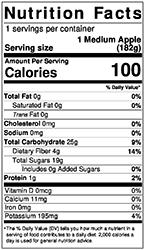 Nutrition Label
Nutrition Label What to Focus on
What to Focus on
What To Focus On
But really, I should point out that there’s an even more important step that should be performed first, before looking at the nutrition label. And that’s looking at the ingredient list. I always look at this list first to get an idea of what foods I’m consuming, what processing has occurred, and what junk has been added. You should be able to recognize this list too! For example, if you were to look at JIF peanut butter, you can see the first ingredient is peanuts. This is good, and its easily recognizable. But what comes after that is added sugar, oils, salt, and something called diglycerides which I have no clue what that is. And then we can use the nutrition label to see how much sugar, oil and salt was added to the peanut butter. And the key here is, we obviously want to eat the least processed versions of food. So, in this case, the JIF peanut butter isn’t too healthy. It’s been stuffed with ingredients that get us to overeat calories and undereat micronutrients. Therefore, you’ll have better luck with the Once Again peanut butter shown below. In this ingredient list, all we see is a whole food we recognize (peanuts) and that’s it! You don’t even need to use the nutrition label in this case because this is the least processed, most optimal peanut butter available.
The other thing to watch out for besides added sugar, salt, and oil is refined grains. Refining grains is a process where the fiber and other important nutrients are removed from the food. Once this has been performed, the carbohydrates are like a glucose injection into the blood stream causing your blood sugar to spike and your body to start storing fat. And you can tell when grains have been refined because the ingredient label usually says enriched or refined. On the opposite end, unrefined grains will usually include the term “whole” like whole wheat flour and ideally some label may say 100% whole grains.
So, to summarize, first use the ingredient label to identify what junk has been added to foods and what’s been refined, and second use the nutrition label to identify how much junk has been added. This will allow you to identify the least processed, and healthiest versions of food around.
Guess The Healthiest Option
So now that you understand the process, here are a few examples you can try now. See if you can guess the healthier version by reading the labels like a dietician!
Which is The Healthier Bread?
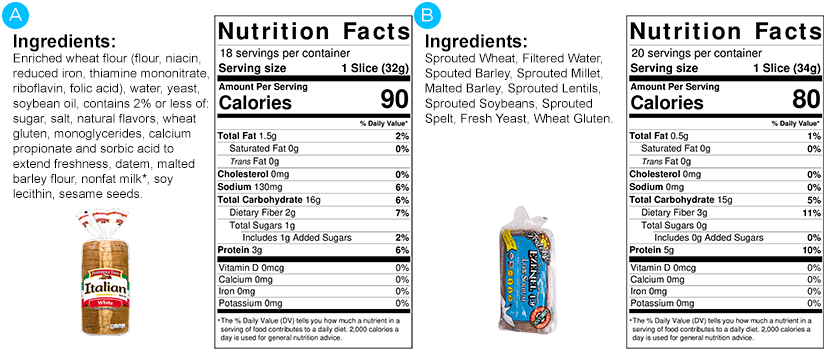
Which is the Healthier Soup?
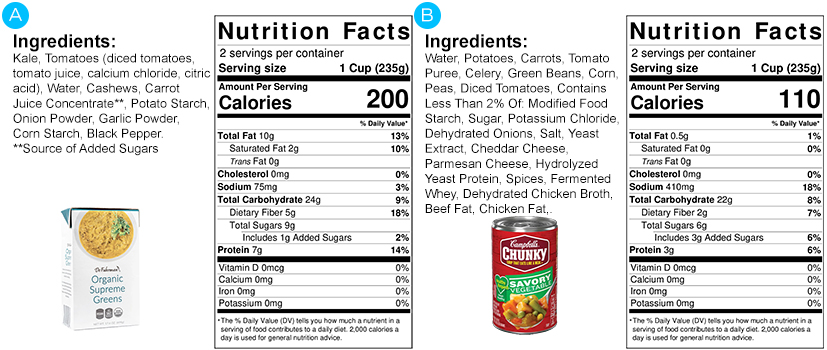
Answers
- B – The second bread is healthier because it uses whole grains without added sugars, salts, and oils. Plus, we can recognize all the ingredients easily.
- A – This one is a little tougher, but the Fuhrman soup is made entirely of whole foods besides the carrot juice concentrate being considered an added sugar. So, the high fat content is healthy fat coming from the cashews. The Campbell’s soup on the other hand has 3x the added sugar, lots of added salt, and added animal fat.
Final Thoughts
It turns out there’s a lot of information on food labels where rocket science may actually be useful. And while I didn’t cover every aspect of the label and all the ways companies can manipulate them, this basic process is enough to make very informed and healthy decisions. First, look at the ingredient list to identify which foods you’re eating, if any refinement has happened, and what junk has been added like salt, oil, and sugar. Then use the nutrition label to see how much of that junk was added. This two-step process is fairly straight forward once you get the hang of it, and it allows you to identify the least processed foods. And the less processing a food undergoes, in general the healthier it is. Allowing you to eat a healthier and happier diet.
Looking for my Top 10 Sleep Tips to effectively manage melatonin levels? Check out my free health kit and weekly newsletter.
Watch a YouTube Video Summarizing the Post

Hey, I am Brandon Zerbe
Welcome to myHealthSciences! My goal has always been to increase quality-of-life with healthy habits that are sustainable, efficient, and effective. I do this by covering topics like Fitness, Nutrition, Sleep, Cognition, Finance and Minimalism. You can read more about me here.
Sources:
- Carrot Juice Nutrition Label
- Pepsi Nutrition Label
- All You Need to Know About the New Nutrition Facts Label
- JIF Peanut Butter Nutrition Label
- Once Again Peanut Butter Nutrition Label
- Many Consumers Misinterpret Food Date Labels, Yet Use Them with Confidence
- Apple Nutrition Information
- Why Refined Carbs Are Bad for You

